

How to drive app growth - 5 expert tips to optimize our funnel!
How to drive app growth - 5 expert tips to optimize our funnel!
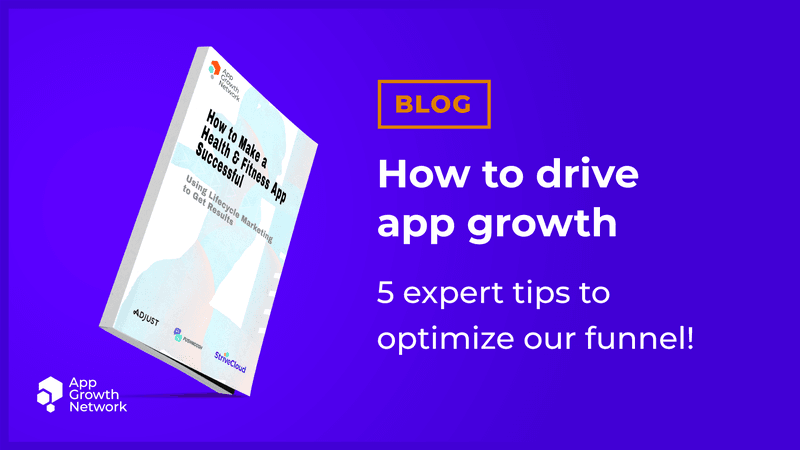
Understanding the app growth funnel is the first step toward optimizing your user acquisition and retention strategy in the competitive mHealth market.
Without a doubt, health is the most universal mobile app category. Every human needs to look after their health in some way, whether it be their diet, sleep, or fitness. In 2021 medical app downloads grew 50% year-over-year, gathering over 3.2 billion downloads across health, fitness & medical apps. But this can be a double-edged sword. A larger market, however, also means more competition, making it not only harder for your app to stand out, but giving unsatisfied users lots of options to switch to alternatives. According to the App Growth Network, the solution to brand differentiation and user churn is customer experience optimization.
The App Growth Network is a leading app marketing agency covering full-funnel app growth for clients like Farmville, Nutrition tracker ‘Cronometer,’ and meditation app ‘Breethe’ just to name a few. Specialized in tactics like App Store Optimization, user acquisition & retention for apps they’ve managed to get results like a 23% increase in conversion and 56% boosts in organic installs.
We’re happy to have collaborated on their latest Ebook on how to make your Health & Fitness app successful. Here’s a quick peek inside on how mHealth apps can drive growth from start to finish:
- The state of mHealth today
- How to optimize the 5 stage customer funnel
- Acquisition: how to increase your user base
- Activation: convert acquired users to engaged users
- Retention: incentivize habit formation
- Re-engagement: a reward system that wins back inactive or churned users
- Monetization: increase revenue & convert free users to paying customers
- TLDR
The state of mHealth today
Depending on what your app offers, you may see user activity fluctuate throughout the year. It might sound obvious, but data from apps like Zwift shows that indoor virtual cycling does better in January than in July. Conversely, you can imagine that diet tracking apps might do better in January, fresh from a season of large Christmas dinners. Even though all the sub-verticals in health might grow differently, the mHealth sector as a whole is experiencing an exciting boom period.
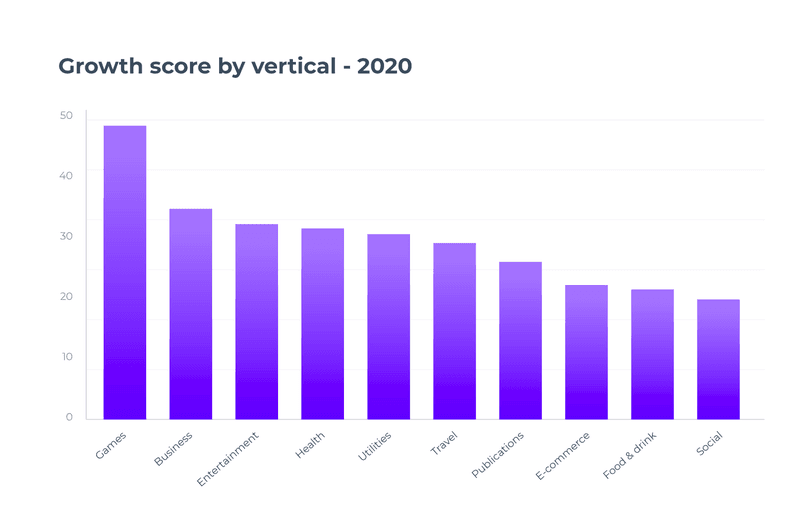
This graph illustrates the significant growth in mobile app categories, with gaming showing the highest increase, a lesson mHealth apps can learn from.
However, as you can see, the biggest growth score belongs to gaming. But gaming doesn’t have a monopoly on what makes games so attractive and engaging. Indeed, mHealth apps can learn from games to produce those kinds of impressive numbers.
How to optimize the 5 stage customer funnel
mHealth may be hugely diverse, but the core challenge remains the same for every app. Essentially, health and fitness apps need to make what can often be a demanding task into something motivating. Even more than that, they need to make task completion into a habit! But when research shows that it takes on average 66 days to form a habit, it isn’t easy to do that. To form a habit that lasts, you need a compelling and engaging reward system. This is where customer experience optimization comes in!
Get the full rundown on how to optimize your app. Download the App Growth Network’s free ebook and start your journey!
To start, the App Growth Network recommends looking at your customer funnel. The lifecycle stages of your typical user will determine which touchpoints to prioritize.
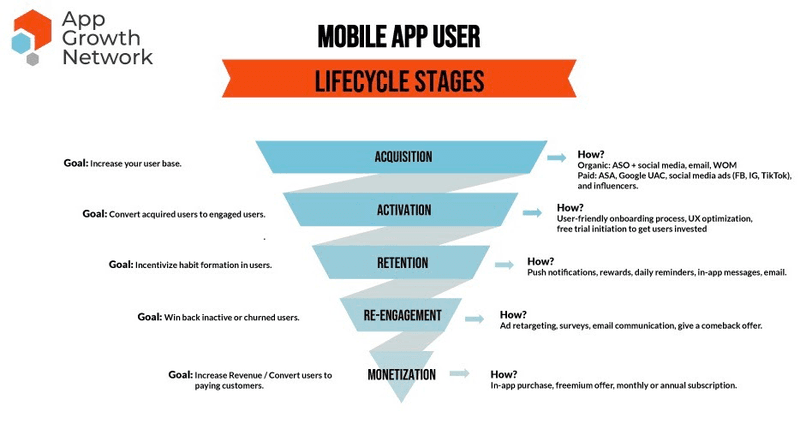
The five-stage customer funnel visualizes the user journey from acquisition to monetization, providing a clear roadmap for optimization.
Acquisition: how to increase your user base
This is the first hurdle that every app needs to overcome. Because this stage happens when a user has no prior brand awareness, acquisition requires a heavy financial cost. You will face stiff competition in acquisition from some apps that have already positioned themselves in the mind of the customer.
- "Many apps need to invest a lot of time and money into this stage, particularly if you’re a Health & Fitness app without previous brand awareness. Celebrity fitness apps, like Carrie Underwood’s Fit52, have an advantage due to their worldwide celebrity status."
But if you don’t have a household name representing your brand, that’s OK, there are other ways to draw in users. To generate organic user acquisition - free, of course - you need effective tactics like App Store Optimization (ASO), word-of-mouth, and other social media strategies.
- "ASO is the most effective way to increase your app’s visibility and make it more discoverable by potential users searching in app stores."
An optimized ASO solution can turn your fortunes around! For the meditation app Ten Percent Happier, the App Growth Network’s advice on ASO rewarded the client with a 10% conversion boost and a 40% increase in installs within 60 days.
Activation: convert acquired users to engaged users
So the user has downloaded your app, but you now need to keep them engaged. What’s important at this stage is an onboarding process that is clear and exciting. Users need to know what’s expected of them and what they can expect in return. If you don’t achieve this, you may turn a potential loyal customer into a frustrated deserter.
So how do you bring customer experience optimization to onboarding?
- Start by asking relevant and easy to answer questions. Fitness apps may ask for your experience level for example.
- Make it clear how long onboarding will take by displaying a progress bar.
- Put off private information questions like names and email addresses until after the user is invested by inputting their level and things like personal goals. - Show that you care about them before you ask for their details!
With this type of onboarding flow, you can boost activation metrics by 4x times or more!
Retention: incentivize habit formation
For health apps, forming a habit is crucial! Retention will define whether your users get something out of your app or not. Certainly, no diet tracker can show significant results in just a few days, no matter how good it is. In the meantime, users want to be rewarded, so you need an effective reward system, or else they will churn - and many do.
- "But here’s the harsh industry fact: the average app in the Health & Fitness category retains only 20% of its users on Day 1. By Day 7, that number drops to less than 9%, meaning over 90% of churned users! At Day 30, only a scant 4% are still around."
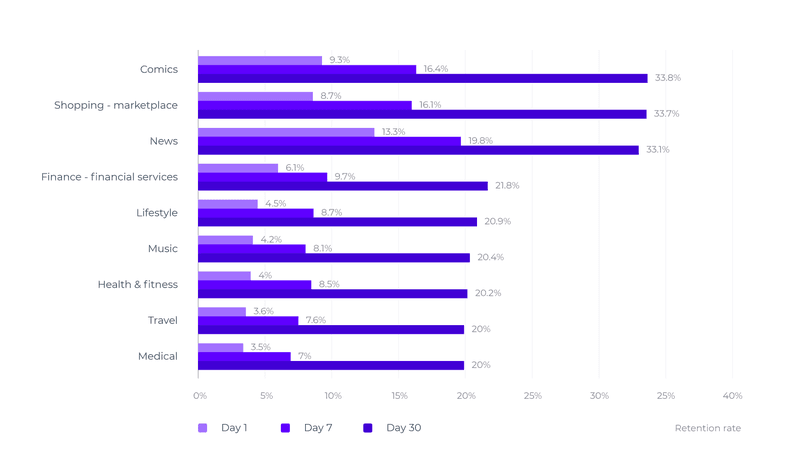
This retention curve starkly illustrates the rapid drop-off of users in health and fitness apps, emphasizing the need for robust engagement strategies.
So you need an app that can engage and excite you! People need to love your product. The App Growth Network’s report recommends a few of the best user retention practices. For one, optimized push notifications will persuade users and push them along their customer journey, rather than jolting them and adding to their digital clutter. Health apps might want to focus on workout reminders and congratulations on results to create an effective and consistent reward system. This brings us to how gamification can help!
StriveCloud - "At StriveCloud, we found that applying design principles like gamification can result in a 500% increase in 90-day user retention for mHealth apps."
Gamification elements such as leaderboards and badges are a great way to achieve customer experience optimization. In essence, most apps already offer extrinsic motivators - such as the need to achieve results - but many miss out on the ever-important intrinsic motivation that gamification offers! In the long-term, users are motivated by more complex and human reasons such as fun, social status, and personal growth. Intrinsic motivation is shown to improve the use of health apps drastically.
How does gamification create healthy habits? Book a free consultation & discover how it could work for you!
Re-engagement: a reward system that wins back inactive or churned users
It’s easy for users to churn. We all know the joke of how New Year’s resolutions never get met - and that phenomenon can particularly affect health & fitness apps. But from a business point of view, you don’t want to let them churn. Indeed, it is more cost-effective to re-engage a user than acquire a new one.
So it’s best to avoid churn, and that can be done by optimizing your strategy to focus on retention. It can be super effective to incentivize lapsed users to return with an enticing reward system such as by offering ‘free stuff’ as a free premium membership or discounts on exclusive events/features.
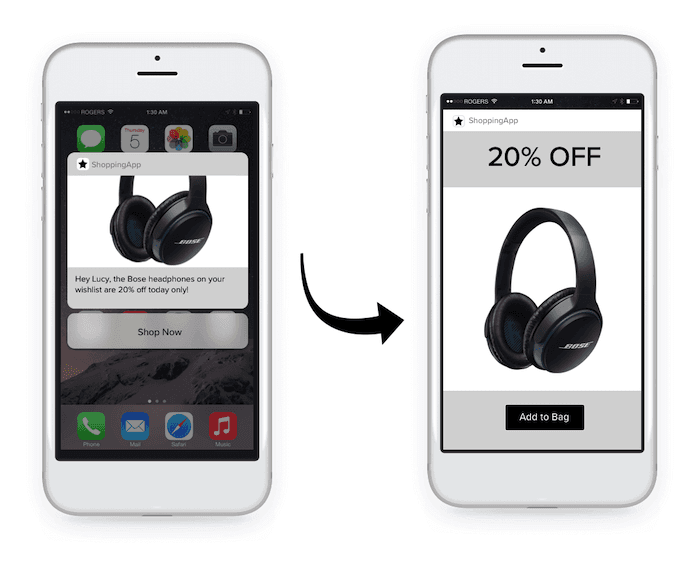
An example of a re-engagement push notification offering a special reward is a proven tactic for winning back lapsed users.
Monetization: increase revenue & convert free users to paying customers
There are many popular models in mHealth for monetization:
Freemium/Subscription
Most health and fitness apps use a freemium or free trial subscription model. The idea is based on reciprocity - you offer something and the user reciprocates by paying once they have seen the value of your app. Some apps limit the free features by time, for example by cutting off free members after 14 days, and others by simply locking away ‘premium features’. This is a popular gamification mechanic called constraint and it works! Science shows the fear of missing out is as motivating as winning.
How does the psychology behind gamification work? Find out on our What is Gamification page!
Paid apps
Some apps require an upfront fee. To be successful with this model though, you need strong branding and positive reviews to generate interest.
In-app advertising
Of course, to keep your app free you can include ads like banners and video interstitials. If users don’t want ads, they can upgrade to a paid version.
In-app purchases
Alternatively, some free apps offer additional purchases in the app to buy extras. This goes back to that constraint dynamic - the locked features will entice users to upgrade!
But there’s more to learn if you want to achieve success as a health & fitness app. To get the full scope on how customer experience optimization can boost your app, download the App Growth Network’s free ebook and start your journey!
TLDR
Health is the most universal mobile app category. However, a larger audience also means increased competition. Therefore churn and retention is especially challenging for mHealth!
The App Growth Network shows the solution is customer experience optimization. A lesson that can be learned from the most popular app category: games!
That doesn’t mean turning your app into a game! Rather design an experience that delights the user so they want to keep coming back.
Here are some quick app growth tips to implement into your funnel:
- Design a reward system that facilitates habit formation.
- App store optimization help less established brands gain more traction & can lead to up to 40% more installs.
- A clear & fun onboarding process leads to almost 4X more activation.
- Gamification can result in a 500% jump in 90-day retention for mHealth apps.
- Focus on retention! It’s more cost-effective to re-engage existing users.
- Monetize with your preferred model, whether it be paid upfront to freemium.
For more expert advice, download the App Growth Network’s free ebook
Related Posts
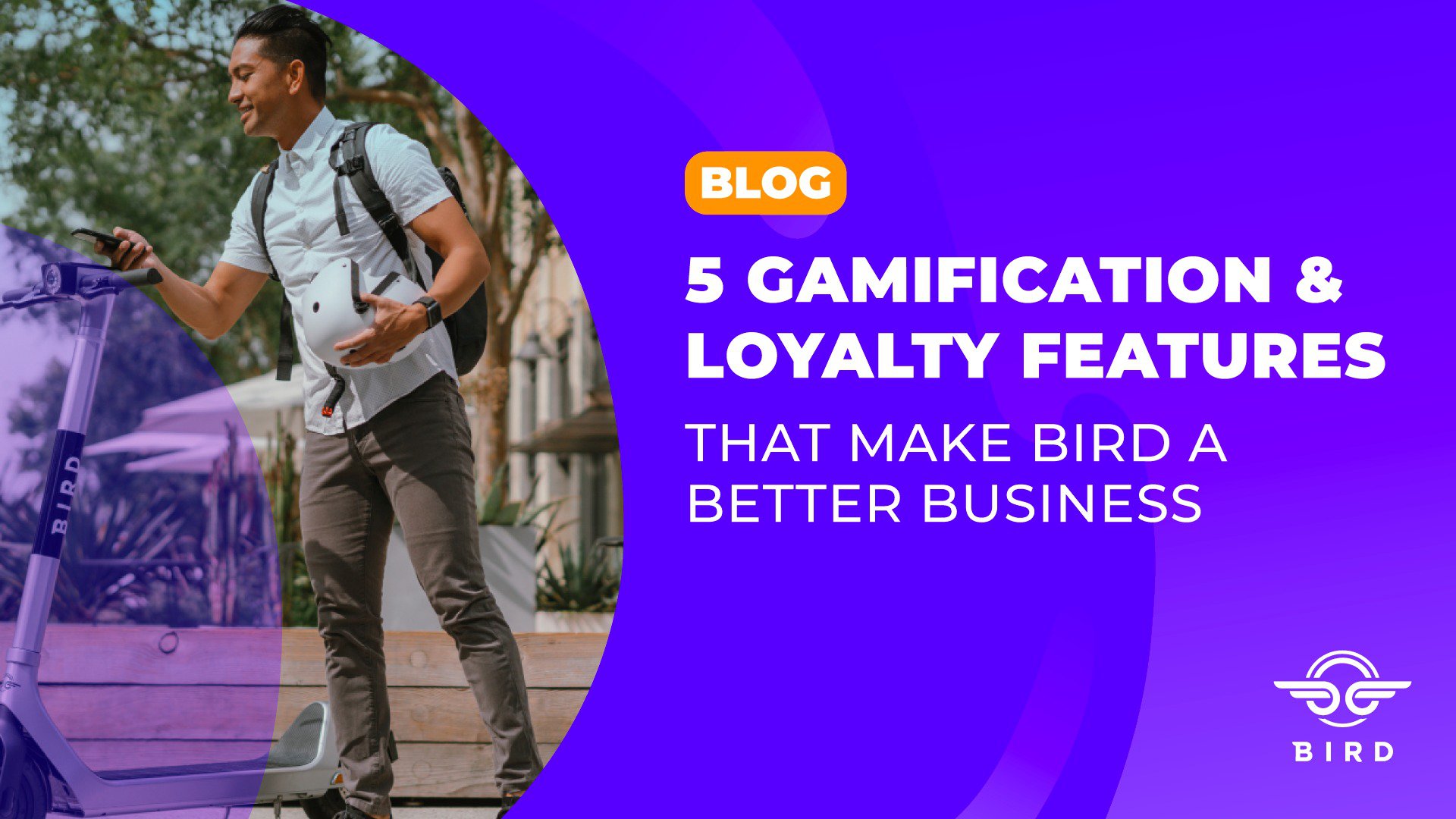
5 gamification & loyalty features that make Bird a better business
Things are changing in micromobility! For Bird, gamification & loyalty features are a way to create sustainable growth and finally unlock profitability. And it's working! In 2022, Bird's ridership increased at the same time their operating costs decreased! Here's how Bird did it.
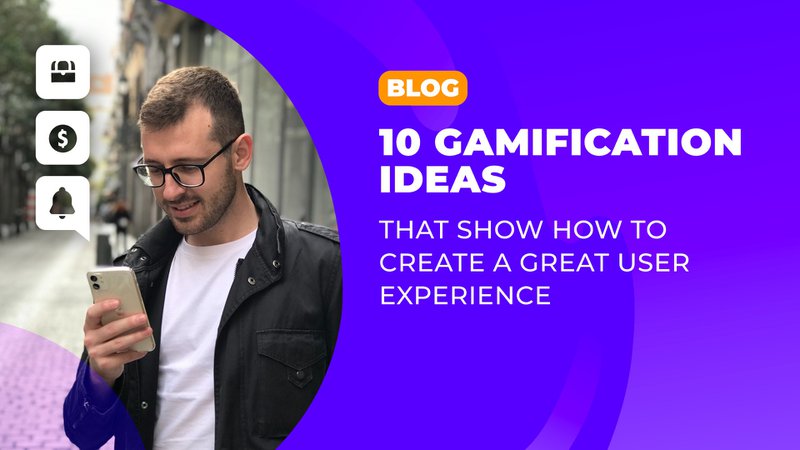
10 gamification ideas that show how to create a great user experience
Gamification is built on the science of motivation. Because this behavioral psychology is common to us all, all kinds of apps can gamify, no matter the audience! So, what motivates your users and how can you leverage that to create growth? Check out 10 gamification ideas in action!

